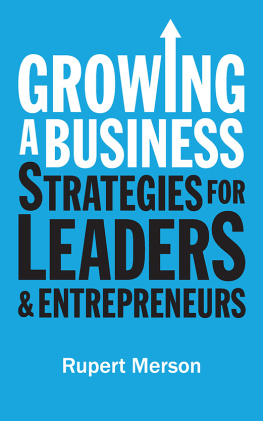


To sign up for the Wharton Digital Press newsletter, visit wdp.wharton.upenn.edu .
Contents
Preface
Introduction: The Growth Challenge
Chapter One: Set the Growth Strategy
Chapter Two: Expand the Search for Growth Opportunities
Chapter Three: Converge on the Best Opportunities
Chapter Four: Apply Innovation Prowess to Accelerate Growth
Conclusion
Appendix A: Positioning Projects on the Matrix
Appendix B: The Real-Win-Worth It Screen
About the Author

For more information, visit wdp.wharton.upenn.edu .
Preface
Is your firm growing at its full potential?
Chances are the answer is no. And thats a problem.
The credible promise of superior growth from a stream of innovations is a powerful driver of a firms stock price. Wall Street knows this, and so does management. This makes the pursuit of organic growthgrowth both in the top line and in profit through internal means, rather than by acquisitionsa very high priority. For 26% of firms in 2010 it was their top priority. Another 71% said organic growth was one of their top three strategic priorities.
This book is for senior management teams charged with achieving the growth goals of their firms. It answers the strategic question of how you can accelerate your rate of organic growth in profits and revenues to one faster than your competitors. In other words, how do you unlock the full growth potential of your firm?
I have spent more than 25 years arriving at the answers to the organic growth challenge presented here. I have been pressed by demanding clients such as General Electric, W.L. Gore & Associates, Medtronic, TE Connectivity (formerly Tyco Electronics), Johnson & Johnson, and many others, and I have been inspired and provoked by participants in dozens of executive programs and strategy sessions, drawing support and insights from colleagues and other students of growth through innovation.
The answer I have come to about what growth leaders have that growth laggards dont can be summed up in the term innovation prowess . Innovation prowess has two facets: First, a highly disciplined growth-seeking process for setting ambitious but achievable growth objectives, with an outside-in approach to finding and selecting the best opportunities. Second, an equal commitment to investing in a culture , in capabilities , and in an organization configuration that support innovation and growth. Growth leaders marry these two facets in a virtuous, self-reinforcing cycle that allows them to convert their ambitions into profitable actions. This means they are able to commit sooner to better growth opportunities and bring them to market faster. Because the entire organization is aligned to growth, their success rates are much better than average. Thats innovation prowess. My hope is that this book will enable readers to develop their own firms innovation prowess.
I am drawn to the metaphor for writing a book that suggests it is like taking a caravan journey in ancient times. Success requires a clear view of the destination, guidance from other travelers on the same path, the resources and will to keep going, and the support of family, friends, and colleagues. I wish that I could single out all those who helped me start and continue the journey to completion of this book. Many have been a part of the Mack Center for Technological Innovation at the Wharton School of the University of Pennsylvania, whose mission is to advance the practice of innovation in organizations; notably, my colleagues Harbir Singh, Nicolaj Siggelkow, Karl Ulrich, and Paul Schoemaker and senior fellows Terry Fadem, Larry Huston, and Daniel Zweidler, from whom I have learned much. This innovative hub in a knowledge network has been generously supported by William and Phyllis Mack, for which I am very grateful. Special thanks go to my colleagues David Robertson and Saikat Chaudhuri for their thoughtful feedback on earlier versions of this book, and to Christine Moorman at Duke Universitys Fuqua School of Business, who was a great help during the development of my thinking.
This journey was started with an invitation from Steve Kobrin and Shannon Berning to consider a book for Wharton Digital Press in the Wharton Executive Essentials Series. Their encouragement and editorial prowess have made this a better book. Tim Ogden of Sona Partners was a guide for this journey, by taking the readers point of view to rewrite and shape the ideas into a persuasive narrative.
This book is dedicated to my children, Sharon, Geoffrey, and Mark, who give me inspiration, and to my wonderful, loving wife, Alice, whose enthusiasm for this project and unfailing support have sustained me.
George S. Day
Villanova, Pennsylvania
January 21, 2013
Introduction: The Growth Challenge
Is your firm struggling to grow because of the following issues?
It has trouble moving successfully from ideas to impact?
It regularly fails to anticipate emerging opportunities and has to react to competitors?
The productivity of its innovation activities is falling behind that of your rivals?
Turf battles and short-term pressures routinely pull innovation resources from ambitious long-term growth initiatives?
The culture is inward looking and risk averse?
No one is held accountable for missed growth projections?
If these are pressing issues, youre not alone.
For all the veneration of innovators in the business and popular press, few firms have a solid grasp of how to drive superior organic growth. But such firms do existand prosper. Growth leaders such as IBM, Nike, American Express, Lego, and Amazon consistently realize organic growth rates exceeding those of their rivals. The purpose of this book is to learn from these growth leaders. With the strategies, processes, and methods discussed in this book you can build a tested and comprehensive template for accelerating your firms organic growth rate.
Peter Drucker, one of the foremost thinkers in management practice, viewed innovation as a discipline, a skill that could be learned and practiced, like playing a musical instrument. He believed that innovation was about devising a systematic way of identifying opportunities that provide new value for customers and exploiting them with disciplined work: What all successful entrepreneurs I have met have in common is not a certain kind of personality but a commitment to the systematic practice of innovation.
But Druckers vision is rarely seen in practice. More often companies are like ActivatorCo, a leading firm in hydraulic systems used to lift elevators and move airplane flaps, with which I consulted. ActivatorCo suffered from having too many projects to absorb with its limited resources. It was entering a number of new markets and expanding its product lines while shifting from hydraulic to linear induction technologies. Few projects were completed properly. Instead of fully prepared product releases with tested new products, the company had product escapes. It felt pressured to push new products out the door without adequate sales training, documentation, or support, which spawned a host of problems that had to be fixed later. Its growth was faltering, the organization was demoralized, and leadership was frustrated.
Next page









